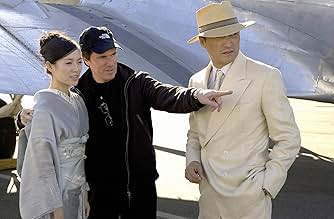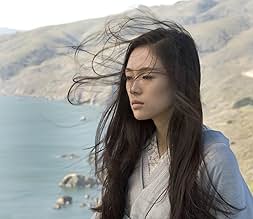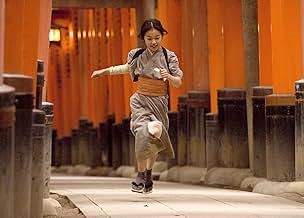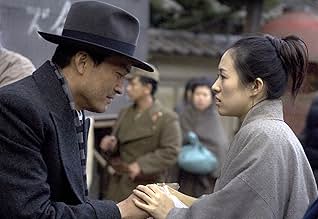Nitta Sayuri revela como ela creceu nas aldeias de pescadores e se tornou uma das gueixas mais famosas do Japão.Nitta Sayuri revela como ela creceu nas aldeias de pescadores e se tornou uma das gueixas mais famosas do Japão.Nitta Sayuri revela como ela creceu nas aldeias de pescadores e se tornou uma das gueixas mais famosas do Japão.
- Ganhou 3 Oscars
- 32 vitórias e 47 indicações no total
- Direção
- Roteiristas
- Elenco e equipe completos
- Produção, bilheteria e muito mais no IMDbPro
Avaliações em destaque
Can a group of American men and Chinese actresses render the world of a Japanese geisha? The answer is yes, with stunning beauty
and regrettable flaws.
Truth be told, this movie was not as bad as its trailer led me to expect it to be. It had a story to tell (although it crumbles in the end),images to show, and material to present. There were ample displays of exquisite beauty -- the trailing tails of silk kimonos, the subtle allure of hand gestures, and the captivating scene of kabuki dance theater ...
On the other hand, the American director was not able to pull the Japanese out of Chinese actresses. (This movie was so crowded by famous Chinese idols that I found myself inadvertently searching for Joan Chen among the cast.) To be fair, all three main actors (Gong Li in particular) show strong performances that made me sympathetic to Rob Marshall's choices. However, they remain utterly Chinese throughout this movie. The look and accent are not the only problems. They lacked the kind of extreme femininity and excessive felicity of the delicately mechanical gesture and movements of traditional Japanese ladies you see in custom dramas of Japanese production. (Michelle Yeoh seems to be the only one trying a little bit of those, but it did not quite work for some reason.)
So, let me re-address the question: Can a group of American men and Chinese actresses render the world of a geisha? The answer, I guess, really depends on what you are looking for. If you would like a little bit of delight from an aesthetically pleasing picture with a dubious authenticity and realism, this movie delivers it. I would not say Rob Marshall failed completely. Memoirs of a Geisha is not the first, nor the last, movie that subjects another culture to the crude lens of American exoticism. It definitely is not the worst one.
Truth be told, this movie was not as bad as its trailer led me to expect it to be. It had a story to tell (although it crumbles in the end),images to show, and material to present. There were ample displays of exquisite beauty -- the trailing tails of silk kimonos, the subtle allure of hand gestures, and the captivating scene of kabuki dance theater ...
On the other hand, the American director was not able to pull the Japanese out of Chinese actresses. (This movie was so crowded by famous Chinese idols that I found myself inadvertently searching for Joan Chen among the cast.) To be fair, all three main actors (Gong Li in particular) show strong performances that made me sympathetic to Rob Marshall's choices. However, they remain utterly Chinese throughout this movie. The look and accent are not the only problems. They lacked the kind of extreme femininity and excessive felicity of the delicately mechanical gesture and movements of traditional Japanese ladies you see in custom dramas of Japanese production. (Michelle Yeoh seems to be the only one trying a little bit of those, but it did not quite work for some reason.)
So, let me re-address the question: Can a group of American men and Chinese actresses render the world of a geisha? The answer, I guess, really depends on what you are looking for. If you would like a little bit of delight from an aesthetically pleasing picture with a dubious authenticity and realism, this movie delivers it. I would not say Rob Marshall failed completely. Memoirs of a Geisha is not the first, nor the last, movie that subjects another culture to the crude lens of American exoticism. It definitely is not the worst one.
I lived in Japan for 3 years and I loved the book, rich with visual imagery. I went to the see the movie with a good deal of trepidation, convinced that they were going to butcher it and sex it up to appeal to American audiences. Instead I sat spellbound in my seat as I watched the images that Arthur Golden has created in my mind with words years before, play themselves out on the screen in front of me. Every shot, ever scene, every tiny detail was just beautiful. I literally did not look away from the screen the entire time. The acting wasn't spectacular. I think they could have found somebody better to play Sayuri. The children were all wonderful. The stand-out actress by far was Gong Li as Hatsumomo. The villain had the best opportunities to show her skills as a thespian. The plot stuck very closely to the book. They eliminated the scenes that they needed to in the interest of time, but they didn't try to take any shortcuts or speed up the plot. I really felt like the story was played out beginning to end without sacrificing any of the meat. You'll read a lot of reviews in the coming weeks praising the gorgeous photography. Every word is true. Words like "lush" and "exquisite" only begin to do it justice. I've never had the experience of being transported to another time by a movie in quite this way.
Why there is so much polarity with the audiences of Rob Marshall's cinematic adaptation of Arthur Golden's exquisite novel MEMOIRS OF A GEISHA is puzzling. Even in the theater there were those who left halfway through - reason unknown. Despite disagreements on the casting techniques and on the emphasis changes between the book and the film, MEMOIRS remains one of the most visually arresting, genteel films of the year. That it comes across as somewhat of an epic soap opera is no one's fault but the writers. And what is so wrong with an old-fashioned soap opera of a story afterall? The opening scene of the turbulent sea and heavy rain that accompany the silent selling of two poor sisters to a merchant planning to place the girls in houses in Osaka gives an indication of the importance of water in this story. The sisters are delivered to a house of geishas and only one is selected by the hard madam. Through years of suffering and anguish the chosen one becomes a geisha, finds comfort from her childhood of poverty, gains loving mentoring by a top geisha, becomes the most sought after geisha in Osaka, finds her love, endures WW II and eventually returns to her dreams. The interplay between the girl and the various members of the geisha training and bartering complex add flavor and conflict that keep the story flowing.
The three principal actresses - Ziyi Zhang, Michelle Yeoh, and Gong Li carry the film well. The large cast includes favorite actors Ken Watanabe and Mako. The settings are splendid, the special effects such as the cherry blossoms, the autumnal reunion of Zhang and Watanabe, Zhang's spellbinding dance - all are brilliant. John Williams' musical score blends the best of Japanese folk music with contemporary writing and is greatly abetted by the talent of Yo-Yo Ma and Itzak Perlman.
Part of the brilliance of Golden's novel was the meticulous explanation of the myriad details of geisha training and demeanor and makeup and tradition, and while the film version touches on these, the bulk of them are passed over. For this viewer there is a problem with understanding the dialogue due to the enunciation by the actors and the covering of much of the dialogue with ambient music. But that is a minor complaint. In all, MEMOIRS OF A GEISHA is an enormously beautiful and affecting film, one that multiple viewings will no doubt enhance the viewers' appreciation. Recommended. Grady Harp, February 06
The three principal actresses - Ziyi Zhang, Michelle Yeoh, and Gong Li carry the film well. The large cast includes favorite actors Ken Watanabe and Mako. The settings are splendid, the special effects such as the cherry blossoms, the autumnal reunion of Zhang and Watanabe, Zhang's spellbinding dance - all are brilliant. John Williams' musical score blends the best of Japanese folk music with contemporary writing and is greatly abetted by the talent of Yo-Yo Ma and Itzak Perlman.
Part of the brilliance of Golden's novel was the meticulous explanation of the myriad details of geisha training and demeanor and makeup and tradition, and while the film version touches on these, the bulk of them are passed over. For this viewer there is a problem with understanding the dialogue due to the enunciation by the actors and the covering of much of the dialogue with ambient music. But that is a minor complaint. In all, MEMOIRS OF A GEISHA is an enormously beautiful and affecting film, one that multiple viewings will no doubt enhance the viewers' appreciation. Recommended. Grady Harp, February 06
Going into the film, I had worries with all the slamming critics have given, even though I didn't read all of them in details. However, I'm happy to say it turns out to be one of more satisfying movie experiences of the year.
First I echo the sentiment that the film is simply technically perfect. The retro-mood it created had me immensed in the world of geisha from beginning to the end. It's very 1930 Shanghai like. The music score isn't as haunting as the one in CTHD, but it is still masterfully composed and fits in the background very well. It's worth seeing for the big screen experience alone. The story also never dragged, as each of the three parts flowed nicely. I normally don't like voice-over, but here it really held the movie together and helped to move the story along.
As for the accents, the problem has definitely been exaggerated. I was expecting a lot of unpleasant broken English to be spoken, but they all sounded fine to good, not just from the most fluent Michelle Yeoh, but Ken Watanabe, Youki Kudoh (who plays Pumpkin) and other supporting casts. Gong Li had a few awkward lines at the beginning, and Ziyi had more and is the one who had to try the hardest, but both pulled off admirably and didn't hurt their performances in the process.
Talking about performances, I think almost all of them did well. It's much more of an ensemble piece, and I was especially impressed by the young Sayuri and Ken Watanabe.
The main problem I have is with character development. It is a Cinderella story at heart, but the good and evil are too clear-cut and lack dimension. I also want to see more ups and downs for the competition between Ziyi and Gong Li. Gong did all she could, but the script didn't allow her to be a worthy opponent. Except for some verbal back-and-forth between the two and a few dirty tricks from Gong, there was no reason to believe why she was the most famous geisha in Japan before Ziyi arrived.
In addition, the Mother character is over-the-top and didn't fit the emotional aspect the film quite well, although she did provide some comical moments. The big dance scene had excellent buildup, but the execution of the dance felt flat. It lasted only about 30 seconds, while doubling that and making it more mesmerizing would have made the whole middle act more effective.
These flaws didn't overshadow the fact that what was put on screen worked for me. Will I be willing to watch it again with friends? In a heartbeat. Will I recommend it to others? Definitely. With that in mind, I give the film an A-.
First I echo the sentiment that the film is simply technically perfect. The retro-mood it created had me immensed in the world of geisha from beginning to the end. It's very 1930 Shanghai like. The music score isn't as haunting as the one in CTHD, but it is still masterfully composed and fits in the background very well. It's worth seeing for the big screen experience alone. The story also never dragged, as each of the three parts flowed nicely. I normally don't like voice-over, but here it really held the movie together and helped to move the story along.
As for the accents, the problem has definitely been exaggerated. I was expecting a lot of unpleasant broken English to be spoken, but they all sounded fine to good, not just from the most fluent Michelle Yeoh, but Ken Watanabe, Youki Kudoh (who plays Pumpkin) and other supporting casts. Gong Li had a few awkward lines at the beginning, and Ziyi had more and is the one who had to try the hardest, but both pulled off admirably and didn't hurt their performances in the process.
Talking about performances, I think almost all of them did well. It's much more of an ensemble piece, and I was especially impressed by the young Sayuri and Ken Watanabe.
The main problem I have is with character development. It is a Cinderella story at heart, but the good and evil are too clear-cut and lack dimension. I also want to see more ups and downs for the competition between Ziyi and Gong Li. Gong did all she could, but the script didn't allow her to be a worthy opponent. Except for some verbal back-and-forth between the two and a few dirty tricks from Gong, there was no reason to believe why she was the most famous geisha in Japan before Ziyi arrived.
In addition, the Mother character is over-the-top and didn't fit the emotional aspect the film quite well, although she did provide some comical moments. The big dance scene had excellent buildup, but the execution of the dance felt flat. It lasted only about 30 seconds, while doubling that and making it more mesmerizing would have made the whole middle act more effective.
These flaws didn't overshadow the fact that what was put on screen worked for me. Will I be willing to watch it again with friends? In a heartbeat. Will I recommend it to others? Definitely. With that in mind, I give the film an A-.
In Japan of the 20's, the nine years old Chyio (Suzuka Ohgo) and her sister Satsu (Samantha Futerman) are sold by her fisherman father to a Geisha house in Miyako. Satsu is not accepted in the house and is sent to a brothel, and along the years, Satsu escapes from he brothel where she lived and the rebel Chyio is left alone, becoming a slave of a geisha. However, six years later, she learns how to become the geisha Sayuri (Ziyi Zhang) with the support of the successful Mameha (Michelle Yeoh), while fighting against the evil and jealousy of the wicked Hatsumomo (Gong Li). While still a child, Chyio falls in love with The Chairman (Ken Watanabe), and in the post-WWII, they meet each other, in a period o changes in Japan with the occupying American forces and the country completely destroyed.
The first half of "Memoirs of a Geisha" is a beautiful drama, telling the story of the country girl Chyio alone and adapting to a new life style in a house of geisha. Then, in the end of World War II, the screenplay becomes a soap-opera and the story becomes lesser and lesser attractive. However, the cinematography, the art direction and the costume design are amazing along the whole movie. But the cast speaking in English and keeping some Japanese words seems quite ridiculous for me. For such a careful production, this seems to be an unforgivable mistake. My vote is eight.
Title (Brazil): "Memórias de uma Gueixa" ("Memoirs of a Geisha")
The first half of "Memoirs of a Geisha" is a beautiful drama, telling the story of the country girl Chyio alone and adapting to a new life style in a house of geisha. Then, in the end of World War II, the screenplay becomes a soap-opera and the story becomes lesser and lesser attractive. However, the cinematography, the art direction and the costume design are amazing along the whole movie. But the cast speaking in English and keeping some Japanese words seems quite ridiculous for me. For such a careful production, this seems to be an unforgivable mistake. My vote is eight.
Title (Brazil): "Memórias de uma Gueixa" ("Memoirs of a Geisha")
Você sabia?
- CuriosidadesThe elements of nature are a running theme through this film and each of the four main Geisha have an elemental character. Sayuri is water, Mameha is wind, Pumpkin is wood (the equivalent of earth) and Hatsumomo is fire.
- Erros de gravaçãoWhen Hatsumomo and Pumpkin are leaving on the night of Pumpkin's debut, neither Mother nor Auntie spark flint on their backs. A Geisha would never leave her okiya without this act being performed as it was believed it brought good luck.
- Cenas durante ou pós-créditosNo studio logos are shown at the beginning; they appear shortened after the end credits and are accompanied by the film's score.
- ConexõesFeatured in The 63rd Annual Golden Globe Awards 2006 (2006)
- Trilhas sonorasAnata No Mono Yo
Written by Takao Saeki and Kôka Sassa
Performed by Noriko Awaya
Courtesy of Columbia Music Entertainment, Inc.
Principais escolhas
Faça login para avaliar e ver a lista de recomendações personalizadas
Detalhes
- Data de lançamento
- País de origem
- Central de atendimento oficial
- Idiomas
- Também conhecido como
- Memorias de una geisha
- Locações de filme
- California State Railroad Museum - 111 I Street, Sacramento, Califórnia, EUA(interiors: railroad station)
- Empresas de produção
- Consulte mais créditos da empresa na IMDbPro
Bilheteria
- Orçamento
- US$ 85.000.000 (estimativa)
- Faturamento bruto nos EUA e Canadá
- US$ 57.490.508
- Fim de semana de estreia nos EUA e Canadá
- US$ 682.504
- 11 de dez. de 2005
- Faturamento bruto mundial
- US$ 162.242.962
- Tempo de duração2 horas 25 minutos
- Cor
- Mixagem de som
- Proporção
- 2.39 : 1
Contribua para esta página
Sugerir uma alteração ou adicionar conteúdo ausente








































